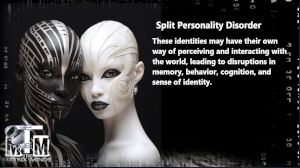Split Personality Disorder, formally known as Dissociative Identity Disorder (DID), is a complex psychological condition characterized by the presence of two or more distinct personality states or identities within an individual.

These identities may have their own way of perceiving and interacting with the world, leading to disruptions in memory, behavior, cognition, and sense of identity. This disorder remains one of the most enigmatic and controversial diagnoses in psychiatry, sparking intrigue and fascination among researchers and the general public alike.
Causes:
The exact cause of Dissociative Identity Disorder is still not fully understood. However, it is believed to develop as a response to severe trauma experienced during childhood, particularly in cases of repeated physical, sexual, or emotional abuse. The theory suggests that dissociation, a defense mechanism employed by the mind to cope with overwhelming stress, results in the fragmentation of identity. Each personality state emerges as a distinct coping mechanism, serving to protect the individual from the pain and anguish associated with the traumatic experiences.
Symptoms:
The symptoms of Dissociative Identity Disorder can vary widely among individuals and may manifest differently over time. Common symptoms include:
- Presence of distinct identities: Individuals with DID may exhibit the presence of two or more distinct personality states, each with its own set of behaviors, attitudes, and memories. These identities may emerge spontaneously or in response to specific triggers.
- Amnesia: Gaps in memory, known as dissociative amnesia, are common in DID. Individuals may experience periods of time for which they have no recollection or may forget significant personal information, such as their name, age, or address.
- Depersonalization and derealization: Feelings of detachment from oneself (depersonalization) or from the surrounding environment (derealization) are prevalent in DID. Individuals may perceive themselves or the world around them as unreal or distorted.
- Identity confusion: A persistent sense of confusion about one’s identity, purpose, or personal history is often reported by individuals with DID. They may struggle to maintain a coherent sense of self and may feel disconnected from their thoughts, emotions, and actions.
- Other associated symptoms: Additional symptoms may include mood swings, depression, anxiety, self-harming behaviors, substance abuse, and suicidal ideation.
Treatment:
Effective treatment for Dissociative Identity Disorder typically involves a combination of psychotherapy, medication, and support from mental health professionals. The primary goal of therapy is to integrate the various personality states into a cohesive identity and address underlying trauma. Therapeutic approaches commonly used in the treatment of DID include:
- Psychotherapy: Psychotherapy, particularly specialized forms such as dialectical behavior therapy (DBT) and eye movement desensitization and reprocessing (EMDR), can help individuals process traumatic memories, improve emotion regulation skills, and enhance communication among different personality states.
- Medication: While there are no medications specifically approved for the treatment of DID, certain psychiatric medications may be prescribed to alleviate associated symptoms such as depression, anxiety, or mood instability.
- Supportive interventions: Building a strong support network comprising family members, friends, and support groups can be invaluable for individuals with DID. Peer support and validation can help reduce feelings of isolation and promote recovery.
In conclusion, Dissociative Identity Disorder is a complex and often misunderstood condition characterized by the presence of multiple distinct personality states within an individual. While the exact cause remains elusive, it is widely believed to stem from severe trauma experienced during childhood. With appropriate treatment and support, individuals with DID can learn to manage their symptoms, integrate their identities, and lead fulfilling lives.
However, it is essential to recognize that recovery from DID is a gradual and challenging process that requires patience, understanding, and a multidisciplinary approach. By increasing awareness, reducing stigma, and providing access to quality mental health care, we can better support individuals living with Dissociative Identity Disorder on their journey toward healing and recovery.
What are your thoughts?



Leave a Reply
Want to join the discussion?Feel free to contribute!